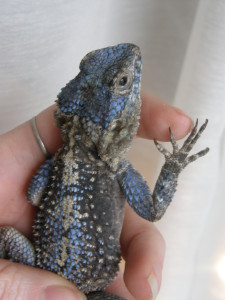Keeping Stellagama/Laudakia stellio
Stellagama/Laudakia stellio
(Clown agama, Painted agama, Painted dragon…)
Description
Stellagama stellio is extremely interesting terrarium pet that is even easier to keep than a bearded dragon because they eat less and keeping their terrarium clean is easier. They are diurnal and very active and fast lizards even when mature. When kept in groups, one can witness lots of interaction between the animals. This species has lots of subspecies. Some of them can be kept together and breed readily. Because of that, there are lots of different hybrids in terrariums that can have most colorful and unusual patterns. Base color of these lizards is usually gray or brown, on top of which they can have blue, yellow, white, orange and even pinkish spots, dots or hue.
They usually don’t show any aggression towards humans, instead being a bit skittish but with proper interaction can become ridiculously tame.
Since their average size is around 30cm they are really easy to handle.
Naturally Stellagama stellio subspecies can be found in southern parts of Europe and on the north coast of Africa. From Greece and Cyprus through Turkey, Syria and Iraq, and into the Saudi Arabia and Egypt.*
It is said to prefer stony and rocky areas. My first experience with this species was on the hotel territory in Turkey, when I saw a large dark-blue lizard sitting on the trunk of a palm tree. It was love from first site.
*- http://www.iucnredlist.org/details/157247/1
Housing
The bigger terrarium you have for them, the better. In literature, there are many different propositions for appropriate terrarium size. I wouldn’t recommend anything less than 60cm x 40cm x 40cm for one and 60cm x 50cm x 100cm for group (1 male and 1-2 females). They enjoy climbing a lot, so decorating terrarium walls with artificial rock is strongly advised.
In general, enclosure should be dry with lots of hiding and climbing spaces, rocks and thick branches. Some nontoxic plants can be used, but consider that everything that they can get their mouths around will be eaten.
Sand, bigger rocks, terrarium carpet or paper towel can be used as a substrate.
There are no size limitation to how big their terrarium can be.
Lighting and heating
These lizards like their light to be quite intensive. They need UVB light for dessert animals.
For heating with these species I prefer using heating bulbs.
Basking spot temperature should be 35-45C. Cooler end temp. 20-25C.
At night drop temperatures to 18-22C and all the light sources should be turned off.
Feeding
Stellagama stellio is generally not picky about food and has usually good appetite. As a main course they should be fed insects (cockroaches, crickets, flies, grasshoppers, mealworms etc). In addition they should also eat different types of plants. They eat well all sorts of salads (green, Roman), Chinese cabbage, dandelion leaves and all sorts of edible greens. In small amounts they can also eat grated carrot and fruits.
Health
Main health problem for terrarium lizards is rickets caused by calcium deficiency. Other types of deficiencies may also occur but they are harder to diagnose. First sign of a mineral deficiency is strange behavior, eating of sand (and other inedible things) and finally bent or broken bones. These issues can be avoided by giving lizards diverse food, calcium and vitamin supplements and using UVB lamp.
Second serious health problem is stress. If you notice that the lizard has gone significantly darker, hides itself constantly or refuses food for longer than one or two weeks, it is time to take a critical look at the keeping conditions. You should check temperatures (hot spot, cooler end), existence of hiding places and the age of the UVB bulb (the bulb should be replaced at least once a year). When all the possible issues have been eliminated the stressed animal should be left alone for a while: go near the terrarium only for feeding and also do not pick up the lizard during that time. If animal loses weight or you feel concerned – consult a vet.
Lizards can also have parasites.


Very nice write-up. I absolutely appreciate this website. Keep it up!
This is so useful! However I would like your input on what percentage UVB to use. Should I go for 10% or 12% ? Thanks in advance.
I use 10%. And I also supplement with vitamin D3 and calcium.